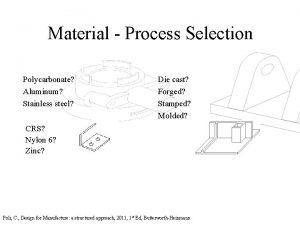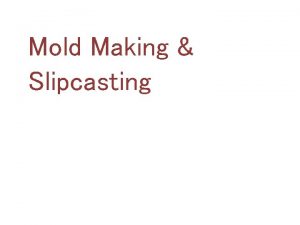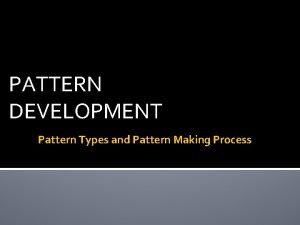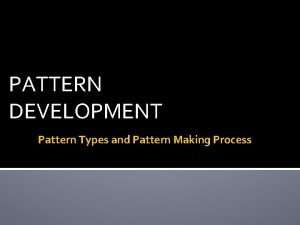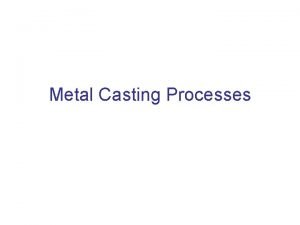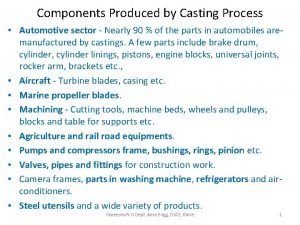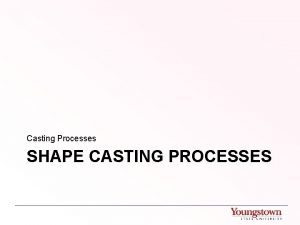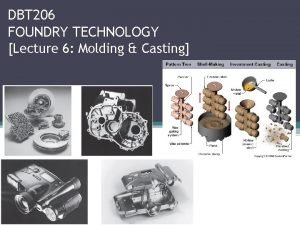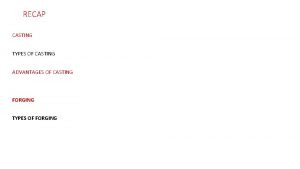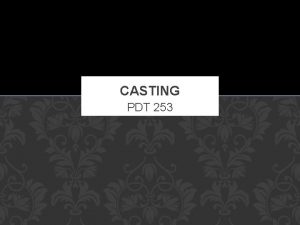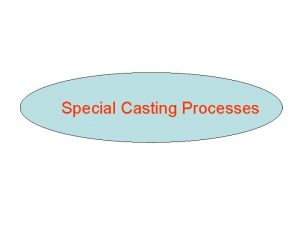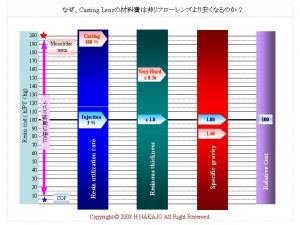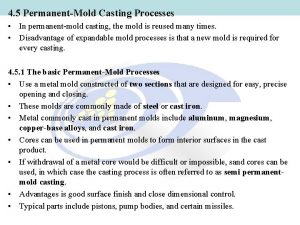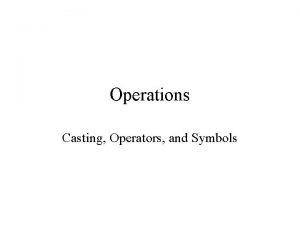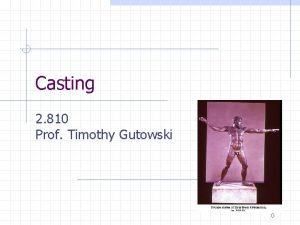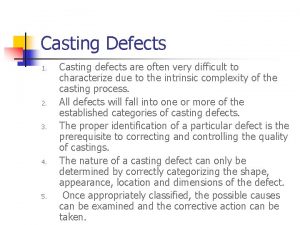Casting Contents Pattern Making Types materials used Pattern


















- Slides: 18

Casting Contents: Pattern Making: Types, materials used, Pattern making allowances Core making: Types, core material & its properties. Moulding: Types of sand moulds, moulding sand composition. moulding sand properties, moulding machines

Pattern Making • Pattern is a replica of the object to be cast • used to prepare the cavity into which molten material will be poured during the casting process. • Patterns used in sand casting may be made of wood, metal, plastics or other materials.

Types of patterns Single-piece or solid pattern • Solid pattern is made of single piece without joints, partings lines or loose pieces. • It is the simplest form of the pattern. • Typical single piece pattern is shown in Fig.

Two-piece or split pattern • Split pattern is made in two pieces which • are joined at the parting line by means • of dowel pins. • The splitting at the parting line is done to facilitate the withdrawal of the pattern.

• Cope and drag pattern • Cope and drag part of the mould are prepared separately. • This is done when the complete mould is too heavy to be handled by one operator. • The pattern is made up of two halves, which are mounted on different plates.

• Loose-piece Pattern • Loose piece pattern is used when pattern is difficult for withdrawal from the mould. • Loose pieces are provided on the pattern and they are the part of pattern. • The main pattern is removed first leaving the loose piece portion of the pattern in the mould. • Finally the loose piece is withdrawal separately leaving the intricate mould.

Pattern Materials Wood Advantages: • Wood is the most popular and commonly used material for pattern making. • It is cheap, easily available in abundance, repairable. • It is very light and can produce highly smooth surface. • Wood can preserve its surface by application of a shellac coating for longer life of the pattern. Limitations: • It is susceptible to shrinkage and warpage and its life is short because of the reasons • it is highly affected by moisture of the molding sand. • After some use it warps and wears out quickly. • It is weak in comparison to metal.

• Metallic patterns are preferred when the number of castings required is large enough to justify their cost. Advantages: • These patterns are not much affected by moisture as wooden pattern. • The wear and tear of this pattern is very less. • Metal is easier to shape the pattern with good precision, surface finish. • It can withstand against corrosion and handling for longer period. It possesses excellent strength to weight ratio. Limitations: • The main disadvantages of metallic patterns are higher cost, higher weight and tendency of rusting. • It is preferred for production of castings in large quantities with same pattern.

Plastic Advantages: • Plastics are getting more popularity now a days because the patterns made of these materials are lighter, stronger, moisture and wear resistant. • They are not affected by the moisture of the molding sand. Moreover they impart very smooth surface finish on the pattern surface. Limitations: • These materials are somewhat fragile, less resistant to sudden loading and their section may need metal reinforcement.

PATTERN ALLOWANCES • The size of a pattern is never kept the same as that of the desired casting because of the fact that during cooling the casting is subjected to various effects and hence to compensate for these effects. • Corresponding allowances are given in the pattern. These various allowances given to pattern are for shrinkage, machining, draft, rapping or shake, distortion, etc.

Shrinkage Allowance • In practice it is found that all common cast metals shrink a significant amount when they are cooled. • The total contraction in volume is divided into the following parts: 1. Liquid contraction 2. Solidifying 3. Solid contraction • The first two are taken compensated by proper gating and risering. • The solid contraction is taken care by the pattern makers by giving a positive shrinkage allowance.

Machining Allowance • It is a positive allowance given to compensate for the amount of material that is lost in machining or finishing the casting. • If this allowance is not given, the casting will become • undersize after machining. • The amount of this allowance depends on the size of casting, methods of machining and the degree of finish. • In general, the value varies from 3 mm. to 18 mm.

Rapping or Shake Allowance • Before withdrawing the pattern it is rapped and thereby the size of the mould cavity increases. • By rapping, the external sections move outwards increasing the size and internal sections move inwards decreasing the size. • This movement may be insignificant in the case of small and medium size castings, but it is significant in the case of large castings. • This allowance is kept negative and hence the pattern is made slightly smaller in dimensions 0. 5 -1. 0 mm.

Core making • Cores are compact mass of core sand • when placed in mould cavity at required location with proper alignment does not allow the molten metal to occupy space for solidification in that portion • hence help to produce hollowness in the casting.

Types of cores


Moulding • A suitable and workable material possessing high refractoriness in nature can be used for mould making. • Thus, the mold making material can be metallic or non-metallic. • For metallic category, the common materials are cast iron, mild steel and alloy steels. • In the non-metallic group molding sands, plaster of paris, graphite, silicon carbide and ceramics are included.

PROPERTIES OF MOULDING SAND • Refractoriness • Permeability • Cohesiveness • Adhesiveness • Green strength • Flowability • Collapsibility
 Basic tools in making simple electrical gadgets
Basic tools in making simple electrical gadgets Marketing concurrent
Marketing concurrent How to make slip casting molds
How to make slip casting molds Process in making a pattern
Process in making a pattern Types of pattern making
Types of pattern making Casting parting line
Casting parting line Skeleton pattern in casting
Skeleton pattern in casting Shape casting
Shape casting Plaster mold casting advantages and disadvantages
Plaster mold casting advantages and disadvantages Color-coding
Color-coding Pit molding
Pit molding Cant stop the feeling trolls go noodle
Cant stop the feeling trolls go noodle Harmful material
Harmful material Man made materials
Man made materials Differentiate adopting materials and adapting materials
Differentiate adopting materials and adapting materials Direct materials budget with multiple materials
Direct materials budget with multiple materials What is inferring
What is inferring War making and state making as organized crime
War making and state making as organized crime Tainos appearance
Tainos appearance

